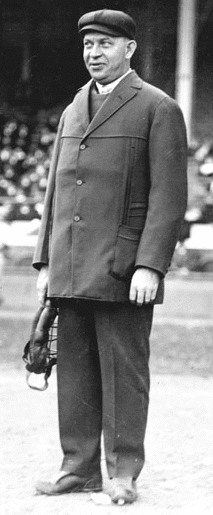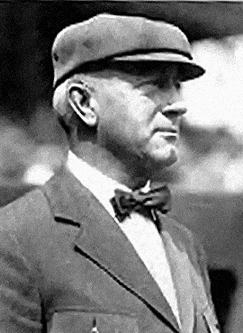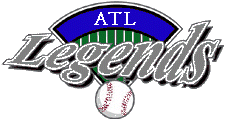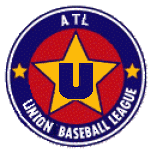
"It ain't nothin' till I call it."
-Bill Klem-
| The ATL Tribute to Umpires |
". .
. shall appoint an Umpire, who shall keep the game in a book provided
for that purpose, and note all violations of the Bylaws and Rules."
-1845, Rules of the Knickerbocker Club of New York-
![[ ]](GREY.GIF) The
"men in black" quietly keep order in the game of base ball. Their fate
is not to strut the bases to the fickle adulation of the crowds, but to
hunker down to do a thankless job amid the catcalls of the mob. We in
the ATL honor them with this Roll Call, a roster of umpires that
we shall imagine are calling it like they see it in every ATL game we
play. Without the Umpire, base ball
would not be The National Pastime.
The
"men in black" quietly keep order in the game of base ball. Their fate
is not to strut the bases to the fickle adulation of the crowds, but to
hunker down to do a thankless job amid the catcalls of the mob. We in
the ATL honor them with this Roll Call, a roster of umpires that
we shall imagine are calling it like they see it in every ATL game we
play. Without the Umpire, base ball
would not be The National Pastime.
![[ ]](GREY.GIF) These
umpires have been culled from the history of the game, and are among
the finest of men to ever don the uniform of the "just arbiter." They
represent all eras of base ball, from the dawning of organized ball in
the latter 1800's, through the dead and lively ball eras, the World War
II days, the expansion years, to the present time. They are a fitting
crew to watch over the honor of the game.
These
umpires have been culled from the history of the game, and are among
the finest of men to ever don the uniform of the "just arbiter." They
represent all eras of base ball, from the dawning of organized ball in
the latter 1800's, through the dead and lively ball eras, the World War
II days, the expansion years, to the present time. They are a fitting
crew to watch over the honor of the game.
| A Short All Time History of Umpires |

![[ ]](GREY.GIF) The
need in base ball for an Umpire to be the sole judge of fair and unfair
play has been recognized for as long as the Game has been played.
Accounts of umpires in match games between gentlemen opponents are
common as far back as the 1840's. In 1858 the National Association of
Base Ball Players sanctioned the use of a single Umpire. When base ball
became professionalized, the institution of umpiring was also
professionalized. In 1871 the National Association of Professional Base Ball Players officially continued the tradition of unpaid volunteer umpires. However, in 1878 the National League of Base Ball Clubs
decided that the Home Team would pay the umpire $5 a game. The next
year William A. Hulbert, the National League President, appointed base
ball's first official Umpire Staff. But this Staff was just a list of
men that the teams could pick a game judge from. It was not until 1882
and the advent the new American Association that the Umpire took on the
role we are so familiar with today. The American Association created
the framework whereupon an Umpire Staff was hired, paid and assigned to
games by the League. The tradition of wearing blue also started here,
as the AA decided that blue flannel coats and caps would be the
official uniform for all umpires. In 1883 the National League adopted
the idea of a permanent, uniformed Umpire Staff paid and appointed by
the league.
The
need in base ball for an Umpire to be the sole judge of fair and unfair
play has been recognized for as long as the Game has been played.
Accounts of umpires in match games between gentlemen opponents are
common as far back as the 1840's. In 1858 the National Association of
Base Ball Players sanctioned the use of a single Umpire. When base ball
became professionalized, the institution of umpiring was also
professionalized. In 1871 the National Association of Professional Base Ball Players officially continued the tradition of unpaid volunteer umpires. However, in 1878 the National League of Base Ball Clubs
decided that the Home Team would pay the umpire $5 a game. The next
year William A. Hulbert, the National League President, appointed base
ball's first official Umpire Staff. But this Staff was just a list of
men that the teams could pick a game judge from. It was not until 1882
and the advent the new American Association that the Umpire took on the
role we are so familiar with today. The American Association created
the framework whereupon an Umpire Staff was hired, paid and assigned to
games by the League. The tradition of wearing blue also started here,
as the AA decided that blue flannel coats and caps would be the
official uniform for all umpires. In 1883 the National League adopted
the idea of a permanent, uniformed Umpire Staff paid and appointed by
the league.
![[ ]](GREY.GIF) The
following interval from 1883 to 1903 was a decidedly dangerous one for
umpires. Team owners resorted to umpire-baiting to increase ticket
sales. The stereotype of the Umpire was quickly reversed from esteemed
arbiter of fair play, to despised villain of questionable intellect.
Umpiring became a very dangerous occupation in the physical sense.
Owners, players and fans all rallied against the lone man in blue on
the field. Physical abuse and mob violence became dangerously
commonplace.
The
following interval from 1883 to 1903 was a decidedly dangerous one for
umpires. Team owners resorted to umpire-baiting to increase ticket
sales. The stereotype of the Umpire was quickly reversed from esteemed
arbiter of fair play, to despised villain of questionable intellect.
Umpiring became a very dangerous occupation in the physical sense.
Owners, players and fans all rallied against the lone man in blue on
the field. Physical abuse and mob violence became dangerously
commonplace.
![[ ]](GREY.GIF) However,
in 1903 Byron Bancroft "Ban" Johnson, president of the American League,
saw the need to provide strong support to the League's umpires. Ban
Johnson created the idea that the umpire on the field was the
representative of the highest officials of the league. The Umpire,
therefore, should be respected and supported throughout all levels of
base ball. Johnson demonstrated his support by suspending players and
enforcing fines and on-field decisions made by his Umpire Staff.
Johnson also molded the Umpire's Code of Conduct, insisting that the
umpire be a tactful overseer of the game. Again, the National League
followed suit -- especially under Presidents John A. Heydler and Thomas
J. Lynch who had both previously been umpires.
However,
in 1903 Byron Bancroft "Ban" Johnson, president of the American League,
saw the need to provide strong support to the League's umpires. Ban
Johnson created the idea that the umpire on the field was the
representative of the highest officials of the league. The Umpire,
therefore, should be respected and supported throughout all levels of
base ball. Johnson demonstrated his support by suspending players and
enforcing fines and on-field decisions made by his Umpire Staff.
Johnson also molded the Umpire's Code of Conduct, insisting that the
umpire be a tactful overseer of the game. Again, the National League
followed suit -- especially under Presidents John A. Heydler and Thomas
J. Lynch who had both previously been umpires.
![[ ]](GREY.GIF) Ban
Johnson also realized that a single umpire was not enough to follow the
action and control the game. He instituted the two-umpire crew where
the Umpire-In-Chief called balls and strikes, while the Field Umpire
controlled the baselines. The National League followed again, and by
1912 it was common practice in both leagues that there would always be
two umpires per game. It was at this time that umpires became figures
of myth and legend because of their exploits on the field. Free from
the threat of physical harm, and free from having to always side with
the home team in close decisions, umpires started becoming prestigious
figures in their own right. This was the time of "Silk" O'Loughlin, who
matched wits and words with the best of players -- and always won. Also
of "Big Tommy" Connolly who become the first League Umpire-In-Chief
after 30 years of game service. Connolly umpired the first American
League game in 1901, and served the League until 1954. There were many
more, such as "Jack" Sheridan who was the first to crouch behind the
plate, and "Billy" Evans who set the standard for appearance and dress
for all umpires who came after him. Perhaps the best was Bill McGowan,
who received universal praise from his colleagues for all of his thirty
years of service.
Ban
Johnson also realized that a single umpire was not enough to follow the
action and control the game. He instituted the two-umpire crew where
the Umpire-In-Chief called balls and strikes, while the Field Umpire
controlled the baselines. The National League followed again, and by
1912 it was common practice in both leagues that there would always be
two umpires per game. It was at this time that umpires became figures
of myth and legend because of their exploits on the field. Free from
the threat of physical harm, and free from having to always side with
the home team in close decisions, umpires started becoming prestigious
figures in their own right. This was the time of "Silk" O'Loughlin, who
matched wits and words with the best of players -- and always won. Also
of "Big Tommy" Connolly who become the first League Umpire-In-Chief
after 30 years of game service. Connolly umpired the first American
League game in 1901, and served the League until 1954. There were many
more, such as "Jack" Sheridan who was the first to crouch behind the
plate, and "Billy" Evans who set the standard for appearance and dress
for all umpires who came after him. Perhaps the best was Bill McGowan,
who received universal praise from his colleagues for all of his thirty
years of service.
![[ ]](GREY.GIF) The
National League had their men of legend too, including Cy Rigler who
began the practice of raising the right hand for calling strikes, and
Hank O'Day who thrived on the technicalities of the rules. O'Day was
the umpire involved in the fateful Merkle Incident of 1908. There was
"Lord" Byron, also known as the Singing Umpire because he sometimes
rendered his verdicts in singsong verse. However, there was one man who
dominated umpiring just as George Herman Ruth dominated events from the
other side: William G. "Bill" Klem. The autocratic Klem insisted on
discipline from all members of both teams, and the fans. He was always
the supreme authority upon the field. In arguments with players he
would draw a line in the dirt and warn, "Don't cross the line!"
The
National League had their men of legend too, including Cy Rigler who
began the practice of raising the right hand for calling strikes, and
Hank O'Day who thrived on the technicalities of the rules. O'Day was
the umpire involved in the fateful Merkle Incident of 1908. There was
"Lord" Byron, also known as the Singing Umpire because he sometimes
rendered his verdicts in singsong verse. However, there was one man who
dominated umpiring just as George Herman Ruth dominated events from the
other side: William G. "Bill" Klem. The autocratic Klem insisted on
discipline from all members of both teams, and the fans. He was always
the supreme authority upon the field. In arguments with players he
would draw a line in the dirt and warn, "Don't cross the line!"
![[ ]](GREY.GIF) Klem
went a stretch of 16 consecutive years working every game behind the
plate instead of rotating with the other umpire as was the custom. He
boasted that he never missed a call in his life, and his honesty and
knowledge of the game were respected by all. The "Old Arbiter" was the
public's personification of the major league umpire.
Klem
went a stretch of 16 consecutive years working every game behind the
plate instead of rotating with the other umpire as was the custom. He
boasted that he never missed a call in his life, and his honesty and
knowledge of the game were respected by all. The "Old Arbiter" was the
public's personification of the major league umpire.
![[ ]](GREY.GIF) Bill
Klem began the NL tradition of using the inside-the-vest chest
protector, while his counterpart in the junior circuit, Tommy Connolly,
began that league's tradition of the balloon protector. Klem also
started the over-the-catcher's-shoulder position for calling balls and
strikes. He used exaggerated arm signals for calls so that every fan in
the stadium would immediately know his decision. While Field Umpire he
also started the practice of straddling the foul lines in order to
sight balls hit down the line as fair or foul. Klem served as the
senior circuit's first Chief of Umpires after he retired from the field
in 1941. It was a position he held until he died in 1951.
Bill
Klem began the NL tradition of using the inside-the-vest chest
protector, while his counterpart in the junior circuit, Tommy Connolly,
began that league's tradition of the balloon protector. Klem also
started the over-the-catcher's-shoulder position for calling balls and
strikes. He used exaggerated arm signals for calls so that every fan in
the stadium would immediately know his decision. While Field Umpire he
also started the practice of straddling the foul lines in order to
sight balls hit down the line as fair or foul. Klem served as the
senior circuit's first Chief of Umpires after he retired from the field
in 1941. It was a position he held until he died in 1951.
![[ ]](GREY.GIF) Most
say it was The Babe who saved the Game from the Black Sox Scandal, and
they may be right. But in a way, it was the integrity and honesty of
the men in blue as independant arbitrators that had much to do with The
Fan regaining trust in the Game.
Most
say it was The Babe who saved the Game from the Black Sox Scandal, and
they may be right. But in a way, it was the integrity and honesty of
the men in blue as independant arbitrators that had much to do with The
Fan regaining trust in the Game.
![[ ]](GREY.GIF) The
three-umpire crew became routine in 1933, and 1952 saw the four-man
crew officially instituted. In both leagues, the umpires regulated play
from the same rule book, but many differences of style and technique
arose between the leagues. This umpiring difference has much to do with
the individual style of play of each League. The National League style
was largely a product of Bill Klem's masterful feel for the game, while
Tommy Connolly's robust, but quiet, authority was the chief progenitor
of the American League style. A prime example is the chest protector.
Klem used the small, inside protector which enabled him to crouch close
over the catcher's shoulder -- allowing him to see the low end of the
strike zone easily. Connolly favored the balloon protector held out in
front of the body, which caused the perceived strike zone to be "high."
From the preferences of these two greats came the NL tradition of low
strikes, and the AL tradition of high strikes. Another example
sometimes missed is that the American League favors umpires who deter
argument by being a physically commanding presence on the field, which
was the persona of big Tommy Connolly. The National League, under the
control of the much smaller and less impressive figure of Klem, tended
to emphasize the intellectual control of the game. These differences of
presence has led to differences in the managerial style of the teams on
the field.
The
three-umpire crew became routine in 1933, and 1952 saw the four-man
crew officially instituted. In both leagues, the umpires regulated play
from the same rule book, but many differences of style and technique
arose between the leagues. This umpiring difference has much to do with
the individual style of play of each League. The National League style
was largely a product of Bill Klem's masterful feel for the game, while
Tommy Connolly's robust, but quiet, authority was the chief progenitor
of the American League style. A prime example is the chest protector.
Klem used the small, inside protector which enabled him to crouch close
over the catcher's shoulder -- allowing him to see the low end of the
strike zone easily. Connolly favored the balloon protector held out in
front of the body, which caused the perceived strike zone to be "high."
From the preferences of these two greats came the NL tradition of low
strikes, and the AL tradition of high strikes. Another example
sometimes missed is that the American League favors umpires who deter
argument by being a physically commanding presence on the field, which
was the persona of big Tommy Connolly. The National League, under the
control of the much smaller and less impressive figure of Klem, tended
to emphasize the intellectual control of the game. These differences of
presence has led to differences in the managerial style of the teams on
the field.
![[ ]](GREY.GIF) Although
umpires today do not enjoy the great respect they received in the
"Golden Years" between the World Wars, they are still the lone arbiter
of fair and unfair play on the green diamond. But whether or not we
agree with their calls on the field, we should always keep in mind that
they are there to preserve the integrity of the game. The institution
of the Umpire deserves thankful respect from every fan. That is why we
in the ATL have made the effort to compile and assign Umpire Crews to
both ATL Leagues even though they do not appear anywhere within the game
itself or on the boxscores. Perhaps Diamond Mind, Inc will rectify that
gross oversight sometime in the future, and we will be ready. We have
assigned nine crews for each league. There are not enough slots available
to honor every umpire deserving of ATL service, and we do not dishonor any
who have been left off of this Roll. The Umpire Crews of the ATL reflect a
cross-section of the men that make up Umpiring History. This Roster is
not intended to be a Hall of Umpiring Fame, though there are more than a
few umpires here who are in a Hall of Fame, or deserve to be.
Although
umpires today do not enjoy the great respect they received in the
"Golden Years" between the World Wars, they are still the lone arbiter
of fair and unfair play on the green diamond. But whether or not we
agree with their calls on the field, we should always keep in mind that
they are there to preserve the integrity of the game. The institution
of the Umpire deserves thankful respect from every fan. That is why we
in the ATL have made the effort to compile and assign Umpire Crews to
both ATL Leagues even though they do not appear anywhere within the game
itself or on the boxscores. Perhaps Diamond Mind, Inc will rectify that
gross oversight sometime in the future, and we will be ready. We have
assigned nine crews for each league. There are not enough slots available
to honor every umpire deserving of ATL service, and we do not dishonor any
who have been left off of this Roll. The Umpire Crews of the ATL reflect a
cross-section of the men that make up Umpiring History. This Roster is
not intended to be a Hall of Umpiring Fame, though there are more than a
few umpires here who are in a Hall of Fame, or deserve to be.

ATL Legends League Umpire Roster
The Umpire Crews are listed with the Crew Chief listed first
Umpire Crew #1
Thomas H. "Tommy" Connolly, John J. Egan, George A. Hildebrand and Franklin H. "Silk" O'Loughlin.
Umpire Crew #2
James G. Honochick, Harry C. Geisel, William T. T. "Bill" Grieve and William R. "Bill" Summers.
Umpire Crew #3
Cal R. Hubbard, Edwin H. Hurley, William F. "Bill" McKinley and Ernest C. Quigley
Umpire Crew #4
George J. Moriarty, John "Homer" Craig, Clarence B. "Brick" Owens and Oliver P. Chill.
Umpire Crew #5
Nestor L. Chylak Jr., Frank W. Umont, James C. "Jim" Odom and John W. Stevens
Umpire Crew #6
Durwood E. Merrill, Joseph N. "Joe" Brinkman, W. W. "Billy" Donaldson, Kenneth J. "Ken" Kaiser.
Umpire Crew #7
Martin J. Springstead, Jerome A. Neudecker, Richard R. "Rich" Garcia and Donald A. "Don" Dekinger.
Umpire Crew #8
Ronald M. "Ron" Luciano, Stephen M. "Steve" Palermo, Vito H. Voltaggio and Frank Dascoli
Umpire Crew #9
Amado Maestri, José M. "Kiko" Magriñat, Armando Rodriguez and Emmet Ashford
"I've
been hit with mudballs and whiskey bottles, and had everything from
shoes to fruits and vegetables thrown at me. I've been hospitalized
with a concussion and broken ribs. I've probably experienced more
violence than any other umpire who ever lived."
-Joe Rue-

ATL Union League Umpire Roster
The Umpire Crews are listed with the Crew Chief listed first
Umpire Crew #1
William J. "Bill" Klem, Jeremiah J. "Miah" Murray, August "Uncle Charley" Moran and Peter "Pete" Cleage.
Umpire Crew #2
William Aloysius "Bill" McGowan, Henry F. "Hank" O'Day, Hezekiah "Ki" Allen and Alonzo P. "Lon" Knight.
Umpire Crew #3
Albert J. "Al" Barlick, Henry C. Crawford, Stanley A. "Stan" Landes and Melvin J. "Mel" Steiner.
Umpire Crew #4
E. Lee Ballanfant, Harry H. Wendelstedt, George Magerkurth and Joe Rue.
Umpire Crew #5
John B. "Jocko" Conlan, Vincent A. "Vinny" Smith, Michael F. Walsh and Lynton R. Bogess.
Umpire Crew #6
Charles "Cy" Rigler, Thomas "Tom" Johnston, Elmer E. Cunningham and Charles T. Reilly.
Umpire Crew #7
Ralph A. "Babe" Pinelli, Lawrence J. "Larry" Goetz, William J. "Lord" Byron and William A. "Bill" Jackowski.
Umpire Crew #8
Billy Evans, Theodore "Teddy" Bomeister, Winfield S. Hastings and Jacob Emmanuel Pike
Umpire Crew #9
Yutaka Ikeda, Hiroya Tomizawa, Osamu Ino and Hiroshi Tani
"All umpires ought to tip their hats whenever Ban Johnson's name is mentioned."
-Clarence "Pants" Rowland - Umpire, Manager & base ball Executive-

Copyright 2005 DMBATL © All Rights Reserved
Copyright 2005 John Mortimer © All Rights Reserved
Copyright 2005 Edward Mortimer © All Rights Reserved



